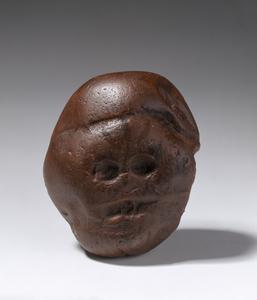The Birth of Want
Posted Under: Things/Thinking
The BBC radio series, A History of The World in 100 Objects has gotten underway, and I’m really into it. It’s written and hosted by the director of the British Museum, Neil MacGregor. Each episode lasts about 15 minutes, and the first one makes a brief case for history-via-objects by considering the Mummy of Hornedjitef, from the 3rd century B.C., described as “one of the most impressive mummy cases” in the British Museum. Like other objects this one sends the sort of “signals from the past” that things can carry. Since it arrived at the museum in 1835, scholars have translated the hieroglyphics and learned about the society the object came from, studied the charms and amulets entombed with the deceased to deduce that society’s beliefs about journeys of the afterlife, and examined its physical makeup to extrapolate the trading networks of the age. Such objects keep sending new signals, as scholars figure out how to receive them.
In the second episode MacGregor dials us back to the beginning of his story: a 1.8 million-year-old “stone chopping tool” found in Olduvai Gorge, in Tanzania (by a Ricahrd Leakey expedition, under the auspices of the British Museum). Discovered next to bones, the chopping tool seems to have been shaped to strip meat and break into the bones of killed wildebeests and the like. “A very, very versatile kitchen implement,” MacGregor offers.
Although the series is explicit in telling the story of human history by way of things humans have made, I think a history of humanity told via objects ought to start with the Makapansgat Pebble (below). As you can see, it looks like a face. It was found in what is now South Africa, and is estimated to be about 3 million years old. What’s significant about it is that the experts believe, based on the makeup of the pebble, that the spot where they found it, among ancient bones and whatnot, indicate that some hominid/human ancestor carried the thing several miles, which would make it the oldest known manuport.
Why was carried away from its place of origin? Well, obviously we don’t know the precise answer, but clearly it’s not a matter of use-value: The pebble is not functional, it’s not a tool. I once heard Mia Fineman, a Met curator and writer, give a talk in which she brought up the Makapansgat Pebble in the context of pareidolia. Pareidolia basically involves spotting patterns that are basically random and attributing meaning to them — like seeing the Virgin Mary’s face in a grilled-cheese sandwich. Possibly the proto-human believed that there was something supernatural about a pebble that looked like a person.
I prefer to imagine one of our distant ancestors saying to another, “Hey, check this out. It looks like a face!”
“Uh huh.”
“Well anyway, I’m keeping it.”
(I realize nobody had language at the time. But I specifically hear them as Ralph and Ed from The Honeymooners.)
Anyway, while the Makapansgat Pebble is not an object that our ancestors made, I think that much like that mummy case, or the Olduvai chopping tool, it sends us a signal across time. Here is a thing, from 3 million years ago, that had no obvious use, but that became a possession anyway. In other words, whatever motivated the owner of this object, he (or she) certainly didn’t need it. And that is the message of the Makapansgat pebble: In the history of material culture, it represents the birth of want.




 "
"













 Kim Fellner's book
Kim Fellner's book  A
A
Reader Comments
A beautiful piece, Rob. Have been thinking on it all day. Want.
Thanks Susan, you’re too kind..
Howdy!
A slightly different way of viewing it…
http://tom-flynn.blogspot.com/2010/01/history-of-world-in-looted-objects.html
This posting gave me much food for thought. I placed some reflections on my own blog, http://www.boym.com/blog
Thank you for doing this, Rob.
Thanks, Zeke & Oh Boym, for the links. Interesting stuff.
I came across your article via the Oh Boym site and it has led me to spend two hours on a snowy Sunday morning in Leeds learning all about the pebble, hominids and human evolution in general! So many thanks, enlightening and inspirational.